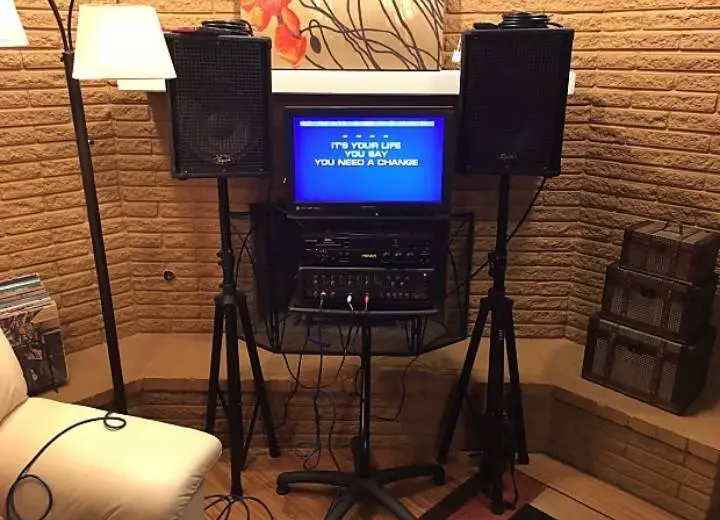
Our guide on how to stop feedback karaoke include five easy-to-do methods:
- Change equalizer settings
- Minimize audio interference
- Position your speaker at the right place
- Enable fewer microphones simultaneously
- Use a feedback eliminator
What Causes Feedback?
Feedback karaoke, or microphone feedback, is a positive gain loop between a loudspeaker and a microphone. Simply put, the speaker amplifies the mic signal, then the mic will collect the sound from it.

This gain loop goes on over and over, causing the system to overload and leading to a terrible screech of feedback karaoke. Microphone feedback occurs only when the mic collects a considerable sound level from the speaker that receives the mic’s signal.
We can name loads of factors contributing to the feedback problem when you’re singing.
- The wrong mic placement
One of the major reasons for the distracting feedback maybe since you place the mic in front or too close to your loudspeaker.
In other words, if you place the speaker behind where you’re standing and holding a mic, feedback is a sure thing. The microphone will pick up whatever sound comes out of the speaker, and the loop will cause feedback.
- The wrong loudspeaker placement
Feedback karaoke is also due to the monitor and speaker’s placement. The dispersion angle may vary but is typically about 60 degrees vertically and 90 degrees horizontally.
Any microphone located in that dispersion area has the potential for feedback. When setting up a sound system, you want to cover as much space as possible so that your audience can hear everything.
- Microphone’s equalization
Feedback happens at different frequencies, depending on the volume of the microphone. You can easily detect the offending frequency if the feedback is a low rumble or a high pitch noise.
Usually, the offending frequencies can be found between 250Hz and 2kHz and between 2kHz and 8kHz. You rarely found it above 8kHz.
- Number of active microphones
The more microphones you turn on, the higher the possibility of feedback. The reason is the mics will pick up more sound, re-entering the system and creating a feedback loop.
How To Stop Feedback Karaoke?
No one wants microphone feedback to ruin their exciting karaoke party. So, understanding and learning how to eliminate feedback karaoke is the first step to ensure smooth sound quality.
We’ve brought some radical solutions to the table that will help do away with microphone feedback.

Change Equalizer Settings
The first strategy is to reset the overall equalizer settings, from the microphone’s gain setting to the speakers’ volume and noise filtering.
- Decrease the microphone’s gain setting so that it won’t collect noise easily.
The gain determines the microphone’s sensitivity to sound and how loudly it picks up noise. Turn the gain on the microphone up until you can just barely hear feedback coming from it.
Then, lower the amount of gain by 5–10 decibels, so it’s less likely to produce feedback while you’re using the microphone.
You can find the gain control either on the audio mixer or the digital audio workstation you’re using. Some microphones also have a gain control knob on them so you can adjust the microphone before it goes into a sound system.
- Reduce the speaker’s volume, so they’re less likely to cause interference.
Speakers that are too loud can cause more audio to bounce around the room and enter the microphone.
If you hear feedback coming from the microphone, reduce the volume on each speaker it’s connected to by about 5 dB at a time to make small adjustments.
Test the microphone and listen for feedback again, turning down the volume more if you need to.
Be careful not to turn the speakers down too much, or else you may not be able to hear the audio clearly.
Only turning down the speakers may not completely reduce feedback. You may need to use additional methods to eliminate it completely.
- Turn down the EQ frequencies by 5 dB at a time to find what causes feedback.
You first set the frequency dials or faders on your equalizer, so they’re at 0 dB. Next, increase the leftmost frequency by 5 dB and test your microphone to see if you hear feedback.
Then, set the frequency back to 0 dB before you test the next one. Continue testing down the line of frequencies and take note of which ones produce the most feedback.
Finally, reduce the volume of the frequencies causing you problems, so the feedback doesn’t sound as prominent.
As you get used to how the feedback sounds, you may be able to detect which frequencies are causing problems by ear.
Reduce Audio Interference
Trying to minimize as much audio interference as possible is another way to stop feedback karaoke. This process includes ways of using your mic properly and removing hard surfaces to reduce bounce.
- Point the microphone away from any speakers it’s connected to.
You shouldn’t hold the microphone directly in front of a speaker or monitor since it will immediately pick up the frequencies and cause feedback.
Instead, it’s better to keep the output speakers in front of the microphone, so it doesn’t capture audio. If you’re holding the microphone, be careful not to bring it past the speakers, or else it may start ringing.
Try using a directional or cardioid microphone because they only pick up sounds from what they’re pointed at.
Please remember to avoid using an omnidirectional microphone since it picks up audio from every angle and is prone to feedback.
- Put the mic as close to your mouth as possible when singing.
More interference can enter the microphone if you keep the audio source far away. When you’re singing karaoke, you’d better hold the microphone directly in front of your mouth, so it only picks up your voice instead of the noise around it.
- Remove some hard surfaces in the room so the sound won’t bounce.
Audio reflects and echoes off of flat surfaces, which can re-enter the microphone and create feedback.
You can start by removing tables and other hard surfaces from the room where you’re using the microphone. Then, try to cover as many surfaces as you can with softer materials, such as carpeting, blankets, or thick tablecloths.
Also, it’s advisable to hang acoustic foam around the room to make irregularly shaped surfaces that don’t produce an echo.
Please note to avoid pointing speakers at walls, ceilings, or windows since they’ll make sounds bounce even more. Instead, point the speakers toward people.
Change The Speaker’s Position
Another method to stop feedback karaoke is to change the position of the speakers so its output won’t feed directly into the mic. We suggest keeping them further forward, like closer to the guests than microphones.
You can move the audio equipment around wherever you want. But keep in mind that always have the microphone and speaker pointing in opposite directions.
Simply said, you need to place them in the following ways:
- Position the speaker in front of the singer, so it’s facing the audience.
- Have the speaker and microphones as far away from each other as possible.
Reduce The Number of Microphones
A more straightforward way to get rid of feedback karaoke is to activate fewer microphones at the same time.
It seems obvious, but the fewer microphones you have, the fewer chances there are for a closed-loop to form, creating the horrible feedback sound.
If your guests are having fun singing altogether and you can’t put a damper on their good mood, then at least try to position them as far away from the speakers as you can.
Also, you have to make sure you keep only the required mics on and turn any extra microphones off when they aren’t in use.
Use A Feedback Eliminator
Feedback eliminators or suppressors can also be purchased, which use a few different methods of controlling feedback. Professionals usually take advantage of feedback eliminators to help promote the audio quality.
We recommend using the three useful feedback eliminating solutions below.
- Frequency shifting is an old technique that helps increase the volume you can reach before hearing feedback.
- Notch filtering is a built-in automatic control of some feedback eliminators. It listens for feedback and then inserts a notch filter at the feedback frequency to block it.
- Adaptive filtering is used to eliminate the source of feedback from the system.
Bye For Now
Feedback karaoke is an annoying issue, painfully ruining your weekend singing party. Things are even worse when audio feedback can damage your sound equipment.
Before throwing a home karaoke game, you should understand clearly how to stop feedback karaoke to ensure a perfect party. You can’t be a great singer without nice sound output, alright?
There are plenty of ways to eliminate microphone feedback that you can put into practice.
Try to apply them properly, and your microphones are ready to party with you!
